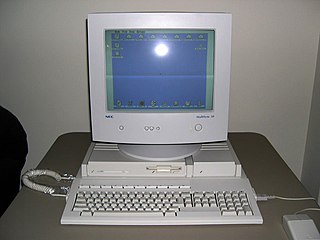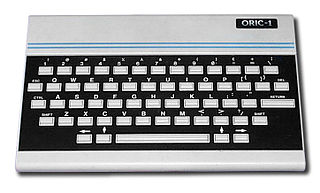Atari System 1
Atari System 1| Manufacturer | Atari |
|---|
| Release date | December 15, 1984 (1984-12-15) |
|---|
| Discontinued | June 19, 1987 (1987-06-19) |
|---|
| CPU | Motorola MC68010L8 (@ 7.159 MHz) |
|---|
| Display | Raster, 336 × 240 pixels (horizontal), 256 colors from palette of 1024 |
|---|
| Input | 8-way joystick, from 1 to 3 buttons |
|---|
The Atari System 1 was Atari Games' first upgradeable arcade game hardware platform. Introduced in 1984, the System 1 platform was used for the following games:
The hardware used a large circuit board with a Motorola 68010 main CPU running at 7.159 MHz, a MOS Technology 6502 sound CPU running at 1.789 MHz, a system ROM, text and graphics display hardware, and control interfaces. Two large edge-card connectors allowed a "cartridge board" to be plugged in; the cartridge board supplied the main program ROMs, sound program ROMs, graphics ROMs, graphics shift registers, a "SLAPSTIC" copy protection chip, a Yamaha YM2151 FM sound generator, a POKEY and (for some games) TI TMS5220 LPC speech synthesis chip. System 1 was capable of generating a max resolution of 336 x 240 with 256 colors from a palette of 1024 colors.
Converting one System 1 game into another generally required replacing the cartridge board, attraction marquee, control panel, and in some cases installing additional controls (e.g., foot pedal for Road Blasters). Several games (most notably Gauntlet and Gauntlet II ) used hardware that was electrically very similar to System 1, but implemented on a single board rather than using a cartridge board. Early System 1 boards and cartridge boards used large numbers of 7400 series TTL chips. These boards were later replaced by the functionally identical "System 1 LSI Main" and "LSI Cartridge" boards, which used ASICs for reduced manufacturing costs. Modular or upgradeable video games were not commonly offered by the major video game companies in the 1970s and 1980s, because it was more profitable to sell an entirely new machine. System 1 and the Japanese JAMMA wiring standard were attempts to move to a modular solution, though there were many smaller companies that sold conversion kits for competitors' hardware.

The Acorn Electron was a lower-cost alternative to the BBC Micro educational/home computer, also developed by Acorn Computers Ltd, to provide many of the features of that more expensive machine at a price more competitive with that of the ZX Spectrum. It had 32 kilobytes of RAM, and its ROM included BBC BASIC II together with the operating system. Announced in 1982 for a possible release the same year, it was eventually introduced on 25 August 1983 priced at £199.

The Atari 5200 SuperSystem or simply Atari 5200 is a home video game console introduced in 1982 by Atari, Inc. as a higher-end complement for the popular Atari Video Computer System. The VCS was renamed to the Atari 2600 at the time of the 5200's launch. Created to compete with Mattel's Intellivision, the 5200 wound up a direct competitor of ColecoVision shortly after its release. While the Coleco system shipped with the first home version of Nintendo's Donkey Kong, the 5200 included the 1978 arcade game Super Breakout which had already appeared on the Atari 8-bit family and Atari VCS in 1979 and 1981 respectively.

The Atari 7800 ProSystem, or simply the Atari 7800, is a home video game console officially released by Atari Corporation in 1986 as the successor to both the Atari 2600 and Atari 5200. It can run almost all Atari 2600 cartridges, making it one of the first consoles with backward compatibility. It shipped with a different model of joystick from the 2600-standard CX40 and Pole Position II as the pack-in game. Most of the announced titles at launch were ports of 1981–83 arcade video games.

The Commodore 64, also known as the C64, is an 8-bit home computer introduced in January 1982 by Commodore International. It has been listed in the Guinness World Records as the highest-selling single computer model of all time, with independent estimates placing the number sold between 12.5 and 17 million units. Volume production started in early 1982, marketing in August for US$595. Preceded by the VIC-20 and Commodore PET, the C64 took its name from its 64 kilobytes(65,536 bytes) of RAM. With support for multicolor sprites and a custom chip for waveform generation, the C64 could create superior visuals and audio compared to systems without such custom hardware.

The Fairchild Channel F, short for "Channel Fun", is a video game console, the first to be based on a microprocessor and to use ROM cartridges instead of having games built-in. It was released by Fairchild Camera and Instrument in November 1976 across North America at a retail price of US$169.95. It was launched as the "Video Entertainment System", but when Atari released its Video Computer System the next year, Fairchild rebranded their machine as "Channel F" while keeping the Video Entertainment System descriptor.

The Intellivision is a home video game console released by Mattel Electronics in 1979. The name is a portmanteau of "intelligent television". Development began in 1977, the same year as the launch of its main competitor, the Atari 2600. In 1984, Mattel sold its video game assets to a former Mattel Electronics executive and investors, eventually becoming INTV Corporation. Game development ran from 1978 to 1990 when the Intellivision was discontinued. From 1980 to 1983, more than 3 million consoles were sold.
The Konix Multisystem was a cancelled video game system under development by Konix, a British manufacturer of computer peripherals.

The Atari 8-bit family is a series of 8-bit home computers introduced by Atari, Inc. in 1979 as the Atari 400 and Atari 800. The series was successively upgraded to Atari 1200XL, Atari 600XL, Atari 800XL, Atari 65XE, Atari 130XE, Atari 800XE, and Atari XEGS, the last discontinued in 1992. They differ primarily in packaging, each based on the MOS Technology 6502 CPU at 1.79 MHz and the same custom coprocessor chips. As the first home computer architecture with coprocessors, it has graphics and sound more advanced than most contemporary machines. Video games were a major draw, and first-person space combat simulator Star Raiders is considered the platform's killer app. The plug-and-play peripherals use the Atari SIO serial bus, with one developer eventually also co-patenting USB.

MAME is a free and open-source emulator designed to recreate the hardware of arcade game systems in software on modern personal computers and other platforms. Its intention is to preserve gaming history by preventing vintage games from being lost or forgotten. It does this by emulating the inner workings of the emulated arcade machines; the ability to actually play the games is considered "a nice side effect". Joystiq has listed MAME as an application that every Windows and Mac gamer should have.

The BallyAstrocade is a second-generation home video game console and simple computer system designed by a team at Midway, at that time the videogame division of Bally. It was originally announced as the "Bally Home Library Computer" in October 1977 and initially made available for mail order in December 1977. But due to production delays, the units were first released to stores in April 1978 and its branding changed to "Bally Professional Arcade". It was marketed only for a limited time before Bally decided to exit the market. The rights were later picked up by a third-party company, who re-released it and sold it until around 1984. The Astrocade is particularly notable for its very powerful graphics capabilities for the time of release, and for the difficulty in accessing those capabilities.

POKEY, an acronym for Pot Keyboard Integrated Circuit, is a digital I/O chip designed by Doug Neubauer at Atari, Inc. for the Atari 8-bit family of home computers. It was first released with the Atari 400 and Atari 800 in 1979 and is included in all later models and the Atari 5200 console. POKEY combines functions for reading paddle controllers (potentiometers) and computer keyboards as well as sound generation and a source for pseduo-random numbers. It produces four voices of distinctive square wave audio, either as clear tones or modified with distortion settings. Neubauer also developed the Atari 8-bit killer application Star Raiders which makes use of POKEY features.

The X68000 is a home computer created by Sharp Corporation. It was first released in 1987 and sold only in Japan.

The Television Interface Adaptor (TIA) is the custom computer chip, along with a variant of the MOS Technology 6502 constituting the heart of the 1977 Atari Video Computer System game console. The TIA generates the screen display, sound effects, and reads the controllers. At the time the Atari VCS was designed, even small amounts of RAM were expensive. The chip was designed around not having a frame buffer, instead requiring detailed programming to create even a simple display.
The CP System II or CPS-2 is an arcade system board that Capcom first used in 1993 for Super Street Fighter II. It was the successor to their previous CP System and Capcom Power System Changer arcade hardware and was succeeded by the CP System III hardware in 1996, of which the CPS-2 would outlive by over four years. The arcade system had new releases for it until the end of 2003, ending with Hyper Street Fighter II.

The CP System is an arcade system board developed by Capcom that ran game software stored on removable daughterboards. More than two dozen arcade titles were released for CPS-1, before Capcom shifted game development over to its successor, the CP System II.
The CP System III or CPS-3 is an arcade system board that was first used by Capcom in 1996 with the arcade game Red Earth. It was the second successor to the CP System arcade hardware, following the CP System II. It would be the last proprietary system board Capcom would produce before moving on to the Dreamcast-based Naomi platform.

The Atari TT030 is a member of the Atari ST family, released in 1990. It was originally intended to be a high-end Unix workstation, but Atari took two years to release a port of Unix SVR4 for the TT, which prevented the TT from ever being seriously considered in its intended market.

Minimig is an open source re-implementation of an Amiga 500 using a field-programmable gate array (FPGA).

Oric was the name used by UK-based Tangerine Computer Systems for a series of 6502-based home computers sold in the 1980s, primarily in Europe.
The EXL 100 is a computer released in 1984 by the French brand Exelvision, based on the TMS 7020 microprocessor from Texas Instruments. This was an uncommon design choice but justified by the fact that the engineering team behind the machine came from Texas instruments. It was part of the government Computing for All plan and 9000 units were used in schools.















